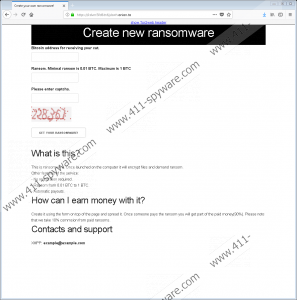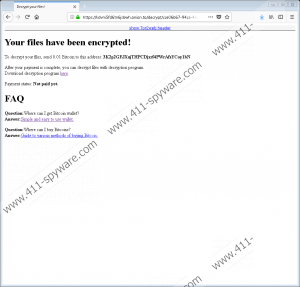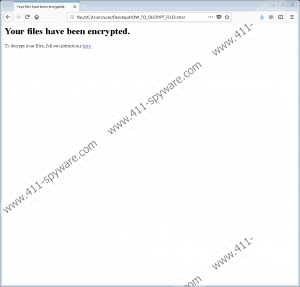Shurl0ckr Ransomware Removal Guide
Shurl0ckr Ransomware is another RaaS (Ransomware as a Service) ransomware, which means that anyone can create it and then start distributing it. Of course, it is not available for free. Cyber criminals who use it for their malicious deeds have to pay 10% of all collected ransoms to the owner of Shurl0ckr Ransomware. Since it might be customized by its creator, the size of the ransom this infection demands varies, but it encrypts users’ files in all the cases after infiltrating their computers successfully. Just like a bunch of other ransomware-type infections, it does that to obtain money from users.You should not give a cent to crooks no matter how badly you need your files back because there are no guarantees that you could unlock your files after you send money to them. No matter if you are going to send them money or not, you need to delete Shurl0ckr Ransomware from your system fully so that you could not launch it again. It cannot start working automatically together with the Windows OS, but if you activate it accidentally, it might lock your files once again.
Researchers working at 411-spyware.com say that Shurl0ckr Ransomware might be closely associated with Gojdue Ransomware. As has been noticed, this threat also locks files on users’ computers and then demands a ransom. We suspect that you will find your pictures, documents, movies, and a number of other files encrypted. You can recognize those encrypted files easily – there will be the .cypher filename extension appended to them all. Unlike some other ransomware infections, it does not remove original extensions of these files and does not rename them. Immediately after encrypting users’ personal data, Shurl0ckr Ransomware also drops a ransom note on their computers. You should find HOW_TO_DECRYPT_FILES.html on your Desktop. If you read it, you will find out why you cannot open your files. Also, you will find out how you can unlock those encrypted files. Shurl0ckr Ransomware also demands money from users. They are told to pay the exact amount of money in Bitcoin indicated on the ransom note. The price of the decryption tool might range from 0.01 BTC (~ 97.54 USD at today’s rate) to 1 BTC (~9754.18 USD at today’s rate). Free decryption software has not been developed yet, so purchasing decryption software from cyber criminals might be the only way to unlock encrypted files. Of course, we do not recommend doing that. You might not be given the decryptor even if you send money to crooks, so there are no guarantees that you could unlock your files. In addition, it would be too naive to expect that cyber criminals will stop developing new malicious applications when they get what they want from users.
Without a doubt, users do not download Shurl0ckr Ransomware consciously from the web. This infection slithers onto their computers without their knowledge. Users find out about its entrance only when they discover encrypted files and the ransom note dropped. Research conducted by our specialists has clearly shown that this malicious application might be distributed via drive-by-downloads. In addition, it might be spread via phishing emails. We cannot guarantee that there are no other tactics to promote it. In some cases, ransomware infections are uploaded to P2P websites and then users download these threats themselves from these pages, so, theoretically, this might be the reason why Shurl0ckr Ransomware has encrypted files on your computer too. In any case, you must remove the ransomware infection from your system ASAP so that it could not cause more problems to you. Once it is gone, you should enable a security application on your computer so that similar infections could not arrive on your computer ever again.
You do not need to know much about the removal of ransomware infections to be able to delete Shurl0ckr Ransomware manually from your computer because it is not sophisticated malware and, as a consequence, it is enough to delete the malicious file launched to make sure it cannot start working again. You should check %USERPROFILE%\Downloads, %USERPROFILE%\Desktop, and %TEMP% directories and remove all suspicious files you find; however, if it happens that you cannot find anything there, you should let an antimalware scanner help you clean your system.
Shurl0ckr Ransomware manual removal guide
- Open Windows Explorer by pressing Win+E on your keyboard.
- Go to %USERPROFILE%\Desktop, %USERPROFILE%\Downloads, and %TEMP% (you can open the directory by inserting it in the Explorer’s URL bar and pressing Enter on your keyboard).
- Remove all suspicious files downloaded recently.
- Empty Recycle bin.
Shurl0ckr Ransomware Screenshots:




